
The treeshrews are small mammals native to the tropical forests of South and Southeast Asia. They make up the entire order Scandentia, which split into two families: the Tupaiidae, and the Ptilocercidae.

Busuanga, is the largest island in the Calamian Group of islands in the province of Palawan in the Philippines. Busuanga Island is the second largest island in the province after Palawan island itself. The island is located halfway between the islands of Mindoro and Palawan with the South China Sea located to the west and the Sulu Sea to the southeast. South of the island are the two other major islands of the Calamian Group: Culion Island and Coron Island. The western third of the island is under the municipality of Busuanga and the eastern two-thirds belong to the municipality of Coron.
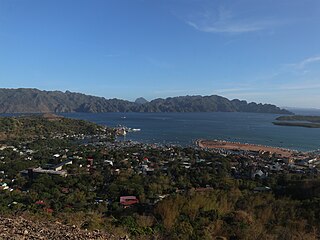
Coron, officially the Municipality of Coron, is a municipality in the province of Palawan, Philippines. According to the 2020 census, it has a population of 65,855 people.

Culion, officially the Municipality of Culion, is a municipality in the province of Palawan, Philippines. According to the 2020 census, it has a population of 23,213 people.

The Calamian Islands or the Calamianes is a group of islands in the province of Palawan, Philippines. It includes:
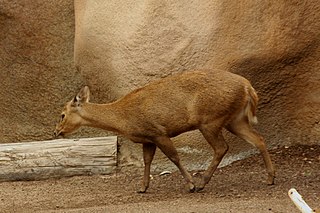
The Calamian deer, also known as Calamian hog deer, is an endangered species of deer found only in the Calamian Islands of Palawan province in the Philippines. It is one of three species of deer native to the Philippines, the other being the Philippine sambar and the Visayan spotted deer.
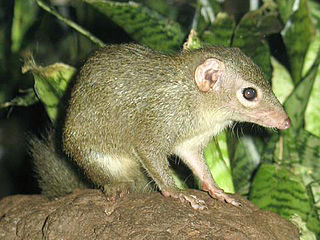
The common treeshrew is a small mammal in the treeshrew family Tupaiidae, and is native to Thailand, Malaysia, and Indonesia. It has been listed as Least Concern by IUCN as it remains common and displays some adaptability to ongoing habitat loss.

The golden-bellied treeshrew is a treeshrew species within the Tupaiidae. It is also called Mentawai treeshrew as it is endemic to the Indonesian Mentawai islands of Sipora, North and South Pagai. It lives in forests, and is considered endangered due to habitat loss since the islands' forests are continuously logged.
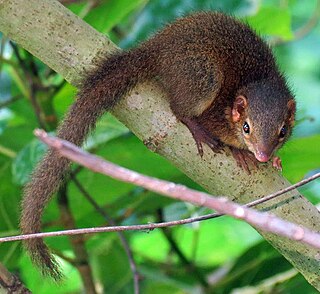
Horsfield's treeshrew, also called Javan treeshrew, is a treeshrew species within the Tupaiidae. It is endemic to the Indonesian islands of Sumatra, Bali, Java and Nias where it inhabits foremost primary forest.

The mountain treeshrew is a treeshrew species within the Tupaiidae. It is endemic to Borneo and inhabits montane forests in Sarawak and Sabah, Malaysia, and Kalimantan, Indonesia.

The Nicobar treeshrew is a treeshrew species within the Tupaiidae. It is endemic to the Nicobar Islands where it inhabits the islands' rain forests. It is threatened by habitat loss.

The Palawan treeshrew is a treeshrew species endemic to the Palawan Island, Philippines, where it occurs from sea level to an elevation of 1,400 m (4,600 ft). The population is considered steady. Formerly, it was considered a subspecies of the common treeshrew.

The painted treeshrew is a treeshrew species of the family Tupaiidae.

The large treeshrew is a treeshrew species within the Tupaiidae. It is native to Sumatra and adjacent small islands, as well as in the lowlands and hills of Borneo.

Tupaia is a treeshrew genus in the family Tupaiidae that was first described by Thomas Stamford Raffles in 1821.

Tupaiidae is one of two families of treeshrews, the other family being Ptilocercidae. The family contains three living genera and 19 living species. The family name derives from tupai, the Malay word for treeshrew and also for squirrel which tupaiids superficially resemble. The former genus Urogale was disbanded in 2011 when the Mindanao treeshrew was moved to Tupaia based on a molecular phylogeny.
Calamian Tagbanwa is spoken in the Calamian Islands just north of Palawan Island, Philippines. It is not mutually intelligible with the other languages of the Tagbanwa people. Ethnologue reports that it is spoken in Busuanga, Coron, Culion, and Linapacan municipalities.

The Bangka Island treeshrew, also known as the Bangkan treeshrew, is a treeshrew species within the Tupaiidae. It was previously listed as a junior synonym to Tupaia glis, but was raised up to species status in 2013. It is only found on Bangka Island, which is off the coast of Sumatra. While there is no study yet about its habitat, it may be similar to T. glis's which resides in primary dipterocarp forest. It is likely that it is threatened by local deforestation.
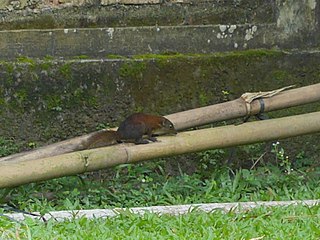
The Sumatran treeshrew is a treeshrew species within the Tupaiidae family. It was previously listed as a subspecies of Tupaia glis for one hundred years, but was raised up to species status in 2013. It is found on the islands of Sumatra and Tanahbala in Indonesia. It is the type species for the Tupaia genus.
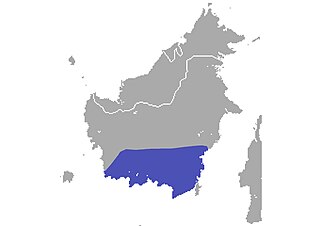
The Kalimantan treeshrew or southern large-footed treeshrew is a treeshrew species within the Tupaiidae family. It was originally described as a subspecies of Tupaia longipes and later listed as a junior synonym of Tupaia glis, before being returned to its subspecies status. It was raised up to species status in 2013. It is found on southern portion of the island of Borneo in Indonesia.



















